Pattern: History and Culture: 2016’s Prelim vs. the Past
| 2015 and earlier | 2016 UPSC Civil Services Preliminary Exam |
|---|---|
| Freedom struggle easy to moderate level questions. |
|
| 1 MCQ on which movement led to split among Moderates vs. Extermist. (Ans was Swadeshi) | It seems, UPSC’s gramophone has stuck on this track. this time two MCQ- 1) why split 2) Swadeshi & Boycott started from? |
| Cabinet Mission asked. | Cripss Mission asked |
| From economic history of British raj, they’ve been asking moderate to tough level MCQs especially in CAPF and CDS. | Thankfully nothing from this side. |
|
|
|
|
| Tough question about rock cut monuments. 4. With reference to the art and archaeo logical history of India, which one among the following was made earliest? (a) Lingaraja Temple at Bhubneshwar (b) Rock-cut Elephant at Dhauli (c) Rock-cut Monuments at Mahabalipuram (d) varaha Image at Udayagiri |
Since 2013, every year they ask minimum one MCQ on rock cut. This time moderate level 40. What is/are common to the two historical places known as Ajanta and Mahabalipuram? 1. Both were built in the same period. 2. Both belong to the same religious denomination. 3. Both have rock-cut monuments. Select the correct answer using the code given below. (a) 1 and 2 only (b) 3 only (c) 1 and 3 only (d) None of the statements given above is correct |
2014: medieval dictionary type MCQs
|
This time, examiner’s “PREM” for Medieval dictionary, is border lining that of a lunatic.
|
|
Three such questions about occupational caste/tribe/nomad
|
| 1 MCQ on Vijaynagar establishment by Harihar | 1 MCQ on Vijaynagar taxation under Krishna Development |
| In 2013, 14, they used to ask tough MCQs from Vedanta and philosophical things. | Thankfully nothing from that side. |
If I spend more time observing the papers, I could come up with more similarities and continuities. But let’s not waste the remainder of our jawaani on this single matter…The conclusion is- 2016’s History-Culture is more akin to 2014’s prelims rather than 2015.
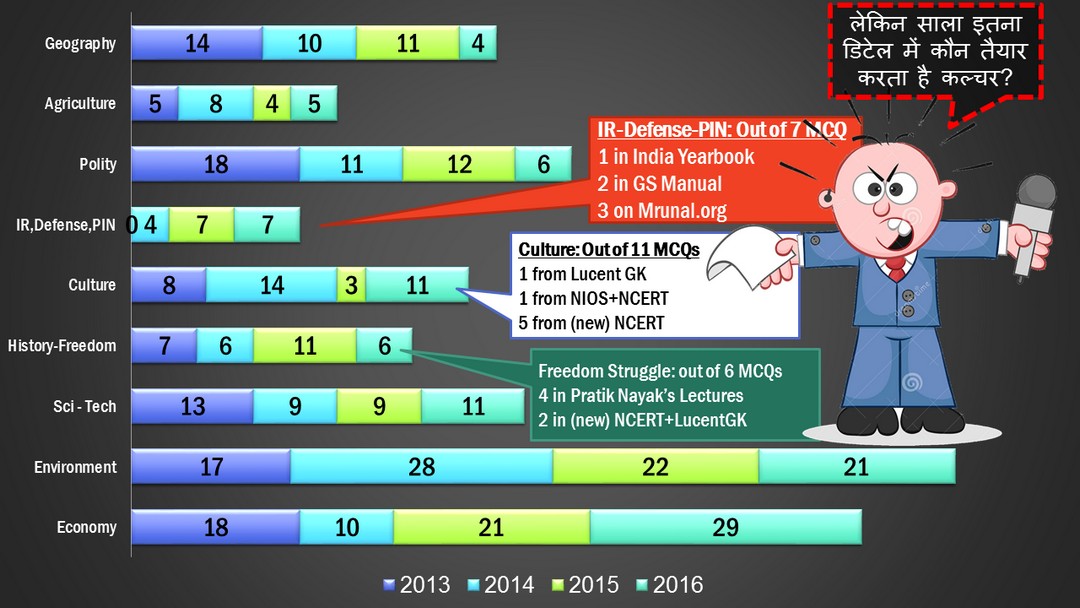
Road ahead for History-Culture
- Good number of culture/medieval MCQs were from non-traditional topics within (New) NCERTs. You should prepare them, with changed glasses.
- Out of 17 MCQs on History-Culture in Prelims-2016, only 5 MCQs are ‘out of book’. Remainder things given in the (new) NCERT, NIOS, Lucent, Spectrum, Pratik Nayak’s Lecture series. Hence they should form the ‘core’ area of preparation.
- But it doesn’t mean 17-5=12 MCQs can be correctly ticked in actual exam. Because in culture-medieval portion very trivial factual information’s asked e.g. Malvikanimtriam is love story of Pushyamitra Sunga’s son. This is given in Lucent GK but who has time to memorize so many details.
- So beyond a point, marginal utility turns negative. You could spent that much time in Economy, environment – and tick more.
Solved: Freedom Struggle (6 MCQs)
24. The `Swadeshi’ and ‘Boycott’ were adopted as methods of struggle for the first time during the
(a) agitation against the Partition of Bengal
(b) Home Rule Movement
(c) Non-Cooperation Movement
(d) visit of the Simon Commission to India
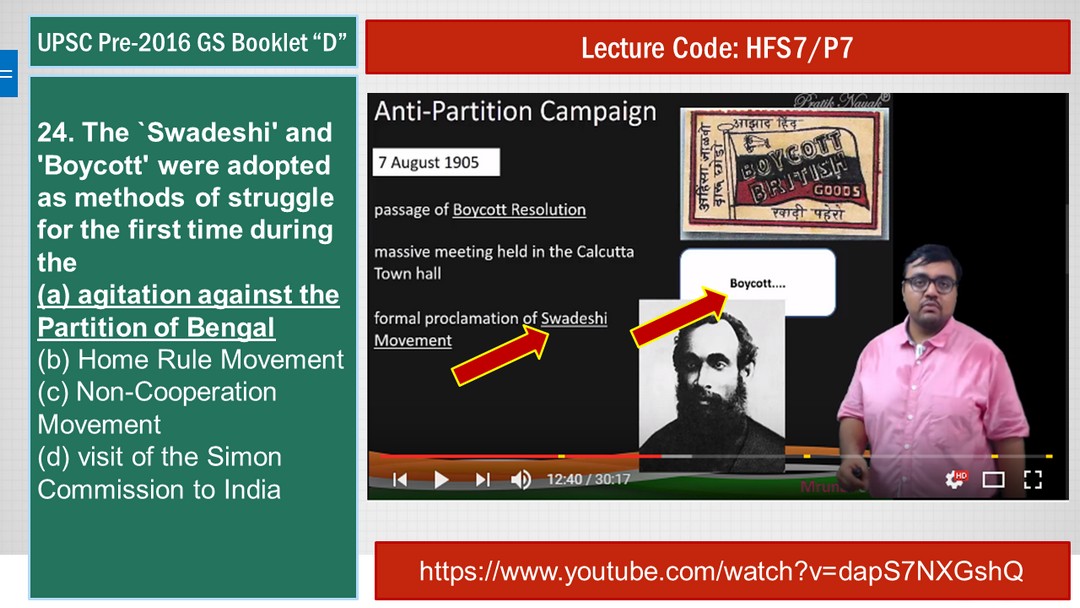
Pratik Nayak’s Lecture HFS7/P7: Swadeshi and Boycott started against Partition of Bengal in 1905. Let’s crosscheck other options as well:
(b) Home Rule Movement: 1916 it started, the demand was of ‘home rule’
(c) Non-Cooperation Movement: 1919, after Gandhi arrived, against removal of khalifa, Punjab wrongs and swaraj
(d) visit of the Simon Commission to India: 1928
33. Satya Shodhak Samaj organized
(a) a movement for upliftment of tribals in Bihar
(b) a temple-entry movement in Gujarat
(c) an anti-caste movement in Maharashtra
(d) a peasant movement in Punjab
Class 12 NCERT History, Page 130: Jyotiba Phule had setup this organization to begin anti-caste movement in Maharashtra.
Tamilandu State board textbook Class-11 also covers.
39. The Montague-Chelmsford Proposals were related to
(a) social reforms
(b) educational reforms
(c) reforms in police administration
(d) constitutional reforms
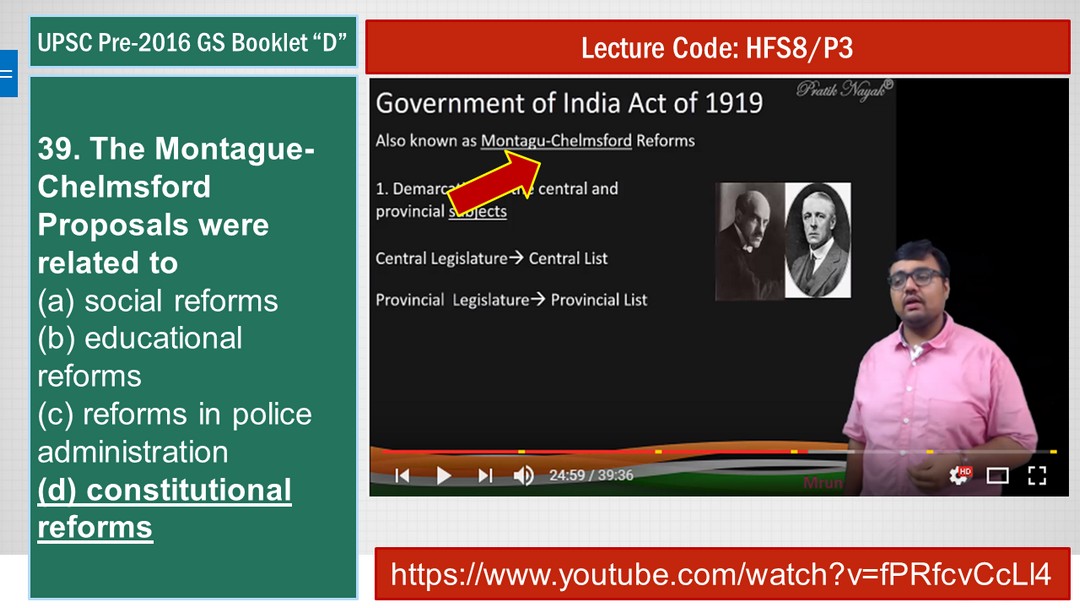
Pratik Nayak’s Lecture HFS8/P3: They’re related to Constitutional reforms.
44. Consider the following :
1. Calcutta Unitarian Committee
2. Tabernacle of New Dispensation
3. Indian Reform Association
Keshab Chandra Sen is associated with the establishment of which of the above?
(a) 1 and 3 only
(b) 2 and 3 only
(c) 3 only
(d) 1, 2 and 3
In 1881, Keshab Chandra Sen established Naba Bidhan ( New Dispensation) meaning new universalist religion after having differences within Brahmo Samaj. He was also part of Indian reform association to legalize Brahmo marriage and to fix minimum age of marriage.
- Calcutta Unitarian Committee was formed by Raja Rammohan Roy, Dwarkanath Tagore and William Adam, hence irrelevant to the question. Hence Option A and D are eliminated.
- From Plassey to Partition (2nd ed.), Shekhar Bandyopadhyay, Page 153, 1st Paragraph: 1881, Keshab Chandra Sen established Naba Bidhan ( New Dispensation) meaning new universalist religion after having differences within Brahmo Samaj. Hence 2nd statement is right. Hence we’re left with Answer B) only 2 and 3.
- Just to cross check, yes third statement is right. Sen formed Indian Reform Association (1870) to persuaded the British government to enact the Native Marriage Act of 1872( Civil marriage act) legalizing Brahmo marriages and fixing minimum marriageable act for boys and girls. Says Lucent GK 4th Ed, Page 98.
67. What was the main reason for the split in the Indian National Congress at Surat in 1907?
(a) Introduction of communalism into Indian politics by Lord Minto
(b) Extremists’ lack of faith in the capacity of the moderates to negotiate with the British Government
(c) Foundation of Muslim League
(d) Aurobindo Ghosh’s inability to be elected as the President of the Indian National Congress
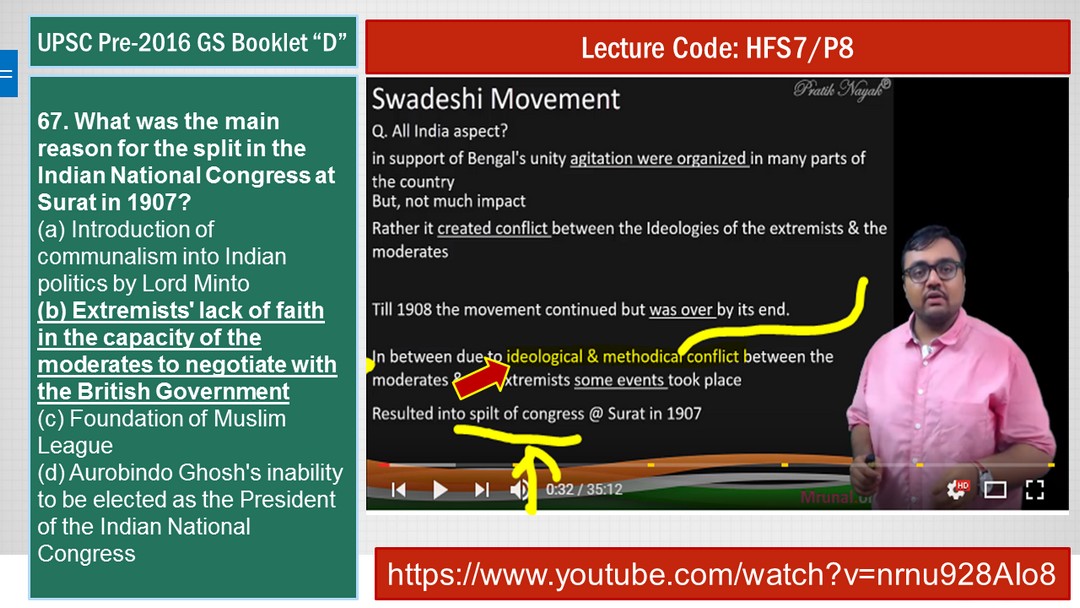
Pratik Nayak’s lecture HFS7/P8: can be answered directly that “B” is the correct choice. Let’s check other options as well:
- Introduction of communalism into Indian politics by Lord Minto: it was introduced in 1909, Morley-Minto Reforms, it took place “AFTER” The split, hence irrelevant.
- Foundation of Muslim League: Established in 1907, but not related to split among congress. Irrelevant.
- Aurobindo Ghosh’s inability to be elected as the President of the Indian National Congress: In 1907, the extremists wanted either Tilak or Lajpat Rai to be president, so when Rasbehari Ghose was announced as president, the extremist resorted to violence. Hence Surat Split. “D” is also wrong.
68. The plan of Sir Stafford Cripps envisaged that after the Second World War
(a) India should be granted complete independence
(b) India should be partitioned into two before granting independence
(c) India should be made a republic with the condition that she will join the Commonwealth
(d) India should be given Dominion status
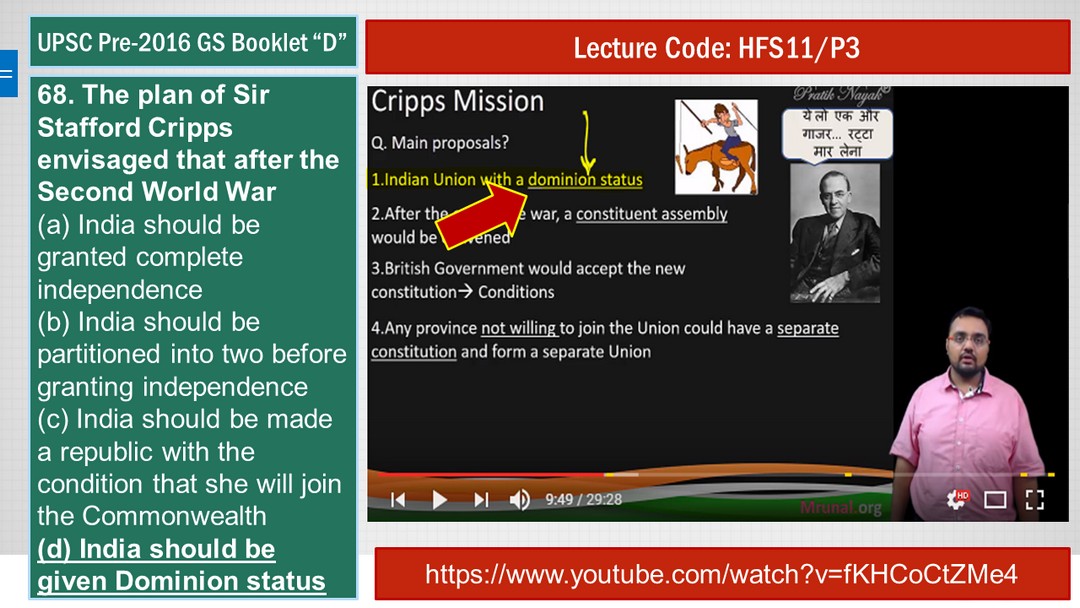
Pratik Nayak’s Lecture HFS11/P3: Cripps proposed to give dominion status to India after WW2. Let’s check other options:
- India should be granted complete independence: Given in Mountbatten Plan: Youtube HFS12/P3
- India should be partitioned into two before granting independence: Youtube HFS12/P3
- India should be made a republic with the condition that she will join the Commonwealth: This decision was made after independence by the constituent assembly.
Solved: Culture/Ancient/Medieval (11 MCQs)
13. Banjaras during the medieval period of Indian history were generally
(a) agriculturists
(b) warriors
(c) weavers
(d) traders
(New) NCERT Class 7 Ch 7: Tribes, Nomads and Settled communities, Page 94-95:
The Banjaras were the most important trader- nomads. Their caravan was called tanda. Sultan Alauddin Khalji used the Banjaras to transport grain to the city markets. Emperor Jahangir wrote in his memoirs that the Banjaras carried grain on their bullocks from different areas and sold it in towns. They transported food grain for the Mughal army during military campaigns. With a large army there could be 100,000 bullocks carrying grain.
14. Who of the following had first deciphered the edicts of Emperor Ashoka?
(a) Georg Bilhler
(b) James Prinsep
(c) Max Muller
(d) William Jones
(New) NCERT Std 12th Themes in India History, Part-I, Page 28-29
It was only after decades of painstaking investigations by several epigraphists that James Prinsep was able to decipher Asokan Brahmi in 1838. He found that most of these mentioned a king referred to as Piyadassi – meaning “pleasant to behold”; there were a few inscriptions which also
referred to the king as Asoka, one of the most famous rulers known from Buddhist texts.
25. With reference to the religious history of India, consider the following statements :
1. The concept of Bodhisattva is central to Hinayana sect of Buddhism.
2. Bodhisattva is a compassionate one on his way to enlightenment.
3. Bodhisattva delays achieving his own salvation to help all sentient beings on their path to it.
Which of the statements given above is/are correct?
(a) 1 only
(b) 2 and 3 only
(c) 2 only
(d) 1, 2 and 3
(New) NCERT Std 12th, Themes in India History, Part-I, Page 103
Page 103: under the sub-heading Mahayan Buddism, they’ve written : “The concept of the Bodhisatta also developed. Bodhisattas were perceived as deeply compassionate beings who accumulated merit through their efforts but used this not to attain nibbana and thereby abandon the world, but to help others. The worship of images of the Buddha and Bodhisattas became an important part of this tradition. This new way of thinking was called Mahayana – literally, the “great vehicle”.
Hence first statement is wrong. This eliminates A and D; while 2nd and 3rd statements are correct and by elimination of #1, there is only one such option left ie. B) 2 and 3 only.
40. What is/are common to the two historical places known as Ajanta and Mahabalipuram?
1. Both were built in the same period.
2. Both belong to the same religious denomination.
3. Both have rock-cut monuments.
Select the correct answer using the code given below.
(a) 1 and 2 only
(b) 3 only
(c) 1 and 3 only
(d) None of the statements given above is correct
Let’s check:
- (New) NCERT Class 11: An Introduction to Indian Art, Page 37 and 83. OR
- Nitin Singhania’s Book on Culture (Macgrawhill Publication): Page 1.17
| Option | Ajanta | Mahabalipuram |
| 1) Period | 200BC to 650 AD by Vakataka Kings | 7th to 8th Century by Pallava Kings |
| 2) Religion | Buddhist cave | Hindu Temple |
| 3) Rock cut | YES, Rock cut caves near Aurangabad, in Maharashtra | YES, |
Hence by elimination, only 3rd statement is right, hence option B)
63. With reference to the economic history of medieval India, the term Araghatta’ refers to
(a) bonded labour
(b) land grants made to military officers
(c) waterwheel used in the irrigation of land
(d) wastel and converted to cultivated land
Can be answered if you’ve read NCERTs with a Persian Dictionary (!) Now, UPSC trolling people through NCERTS. (New) NCERT Class 7 Page 6 and 7 discusses invention of Persian wheel in irrigation. Upon searching google book– we find this device was known as “Araghatta”. साला इतना डिटेल में कोन तेयार करता है?
64. With reference to the cultural history of India, the memorizing of chronicles, dynastic histories and Epictales was the profession of who of the following?
(a) Shramana
(b) Parivraaj
(c) Agrahaarika
(d) Maagadha
Through google books and net searching, we find
- Sharamana: related to Jainism
- Parivraaj: wandering recluse
- Agrahaarika: related to land grants given to Brahmins
- Maagadha were associated with memorizing of chronicles, dynastic histories and Epictales. Ref: Google Book
Hence D is the right choice.
69. Consider the following pairs:
| Famous place | Region |
| 1. Bodhgaya | Baghelkhand |
| 2. Khajuraho | Bundelkhand |
| 3. Shirdi | Vidarbha |
| 4. Nasik (Nashik) | Malwa |
| 5. Tirupati | Rayalaseema |
Which of the pairs given above are correctly matched?
(a) 1, 2 and 4
(b) 2, 3, 4 and 5
(c) 2 and 5 only
(d) 1, 3, 4 and 5
- (New) NCERT Class 11 Page 28: Bodhgaya is in Bihar. Hence A and D eliminated.
- NIOS Culture PDF, Page 194: Chandella Kings built Khajuraho in Bundelkhand region of Madhya Pradesh. Hence #2 is right. But it doesn’t help in elimination, we are still left with B or C.
- It’s common knowledge that Nashik is located in Maharashtra. Now observe the map given on (new) NCERT class 9 ch.2- Nashik ought to be in somewhere in or around Deccan plateau, rather than Malwa plateau. Hence #4 is wrong. By elimination, now we are left with only C) 2 and 5.
92. With reference to the cultural history of medieval India, consider the following statements :
1. Siddhas (Sittars) of Tamil region were monotheistic and condemned idolatry.
2. Lingayats of Kannada region questioned the theory of rebirth and rejected the caste hierarchy.
Which of the statements given above is/are correct?
(a) 1 only
(b) 2 only
(c) Both 1 and 2
(d) Neither 1 nor 2
(New) NCERT Std 12th Themes in India History, Part-II:
- Page 147: The Lingayats challenged the idea of caste and the “pollution” attributed to certain groups by Brahmanas. They also questioned the theory of rebirth. Hence 2nd statement is right.
- Page 148: At the same time other religious leaders, who did not function within the orthodox Brahmanical framework, were gaining ground. These included the Naths, Jogis and Siddhas. Many of them came from artisanal groups, including weavers. From this, it can be inferred that statement 1 is also right. But just for the sake of crosschecking- yes Google Book also confirms (Ref#1).
84. Regarding the taxation system of Krishna Deva, the ruler of Vijayanagar, consider the following statements :
1. The tax rate on land was fixed depending on the quality of the land.
2. Private owners of workshops paid an industries tax.
Which of the statements given above is/are correct?
(a) 1 only
(b) 2 only
(c) Both 1 and 2
(d) Neither 1 nor 2
Difficult to find source material that specifically pinpoints Krishna Deva’s Fiscal policy. But from Indian History by Krishna Reddy, we find that in Vijaya Nagar empire:
- Land revenue varied according to nature of cultivated land. So, #1 is right.
- There were taxes on various professions. So #2 may be true (most probably)
Another source- From the travelogue written by Persian envoy Abdur Razzaq in the court of Vijaynagar- and mentioned in RC Majmoodar’s Advanced History of India, gives similar hints.
Anyways, UPSC official Answerkey will clear it.
85. Which one of the following books of ancient India has the love story of the son of the founder of Sunga dynasty?
(a) Swapnavasavadatta
(b) Malavikagnirnitra
(c) Meghadoota
(d) Ratnavali
Lucent GK, Page 35: Sunga Dynasty was established by Pushyamitra Sunga…..He was succeeded by his son Agnimitra-the hero of Kalidasa’s drama “Malvikagnimitra” Hence answer has to be (B). Sanskrit play by Kalidas, tells the story of the love of Agnimitra, the Shunga Emperor at Vidisha, for the beautiful hand-maiden of his chief queen.
Anyways, let’s also prepare the remaining options (through net surfing) – incase the question gets recycled in some other exam!
- Swapnavasavadatta: Sanskrit play written by Bhasa about romantic narratives about the Vatsa king Udayana and Vasavadatta, the daughter of Pradyota, the ruler of Avanti
- Malavikagnirnitra: Sanskrit play by Kalidas, tells the story of the love of Agnimitra, the Shunga Emperor at Vidisha, for the beautiful hand-maiden of his chief queen
- Meghadoota: lyric poem written by Kalidas, story of a king who convinces a passing cloud (megh) to convey a message (doota-messenger) his wife
- Ratnavali: Drama between Queen Ratnavali and King Udayana.
55. In the context of the history of India, consider the following pairs:
| Term | Description |
| (1) Eripatti | Land revenue from which was set apart for the maintenance of the village tank |
| (2) Taniyurs | Villages donated to a single Brahmin or a group of Brahmins |
| (3) Ghatikas | Colleges generally attached to the temples |
Which of the pairs given above is/are correctly matched?
(a) 1 and 2
(b) 3 only
(c) 2 and 3
(d) 1 and 3
- 1st pair is correct, as per Romila Thapar’s Book on Ancient India
- NIOS Culture PDF Page 258: In the seventh and eighth centuries, ‘ghatikas’, or colleges attached to the temples emerged as new centres of learning. The ‘ghatikas’, provided Brahmanical education in Sanskrit medium. So, statement #3 is right. This eliminates A)
- Indian History, Krishna Reddy Page B-58: Cholas created revenue units called “Taniyur” out of larger Brahmadeya. From NCERT Class 7 Page 26, we know that Brahmadeya means land gifted to Brahmanas. So, #2 may be right, may be wrong. But there is no option with 1, 2 and 3 correct. So, we can safely take #2 as wrong.
Hence, Only 1 and 3 are correctly matched.
Anyways stupid and tough question. Who has time to memorize Ancient-Medieval dictionary. The collective amount of time and energy wasted in searching this answer by UPSC aspirants on internet….utne mein toh atleast one MNREGA pond could have been dug up.
Pattern: IR-Defense-PIN- 2016 vs the past
| 2015 and before | 2016’s prelim paper |
|---|---|
| They mostly asked ‘contemporary’ current type MCQ that were spread through months, rather than one specific event. |
|
| Amnesty international is (ans. Human rights NGO) | Doctors without border is (Ans. Medical NGO) |
Organization vs members
|
GCC doesn’t include (in other words, Iran is not member of which group!) |
Term/initiative vs. who they’re associated with
|
Belt and road initiative is by whom? Ans. China |
| IOR-ARC: Origin/feature/purpose of organization – Two statement true/false type MCQ | Similar MCQs from
|
| Defense- 2014: a rather tough MCQ about Agni Missile | Easy / Moderate question on INS Astradharini’ (given in IYB) |
| UPSC had stopped asking PIN (Persons in News)since inception of CSAT system in 2011 | Finally resumed- with a rather easy MCQ- A man who knew infinity -movie on Mathematician S.Ramanujan’s life. |
Road Ahead: IR / Defense for Prelims-2017
- 1) Doctor without border, 2) GCC-members: these two MCQs are verbatim given in same page Macgrawhill’s GS Manual. Due to paucity of time, I’ve not checked others- but I’m sure such Intl. org. ready reference tables are available in Pearson, Spectrum and other GS manuals as well. You should atleast go through a 2nd hand copy of it.
- Even India yearbook should be carefully read, including the ‘current events diary’ given in the last pages. INS Astradharini answer was directly given in it.
- Apart from this, you’ve to cultivate habit to read theHindu / Indian express (Rajamohan) on regular basis. It may be possible to finish prelim-specific matter through jugaad-panti, But for mains-interview, the command over the diplomatic vocabulary, language, sentence formation and ideas, can’t come without reading the original editorials.
- IR-defense they’ve been asking since last two years continuously, so it’s not an unexpected pattern. But yes, some of them require factual memory e.g. India-Africa summit in 2015 was 3rd summit or not? – so, it’s difficult to solve.
- To an extend, some may find IR-MCQ section to be “pro-senior player”, but given the nature of the factual details asked- some are solvable for all (e.g. belt and road), and some are solvable by (almost) none of the players- irrespective of whether fresher / senior.
Solved: International relations (IR) & Diplomacy MCQs
17. Consider the following statements:
The India-Africa Summit
1. held in 2015 was the third such Summit
2. was actually initiated by Jawaharlal Nehru in 1951
Which of the statements given above is/are correct?
(a) 1 only
(b) 2 only
(c) Both 1 and 2
(d) Neither 1 nor 2
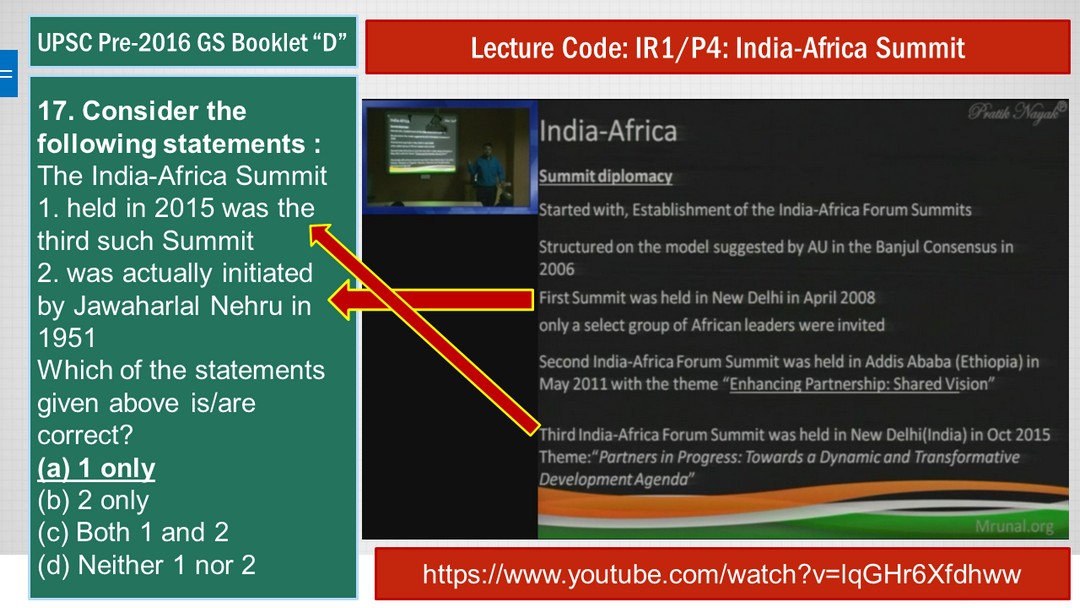
Prateek Nayak lecture (IR1/P5); Slides no- 24.
- 1st statement is right: Third India-Africa Forum Summit was held in New Delhi(India) in Oct 2015 Theme: “Partners in Progress: Towards a Dynamic and Transformative Development Agenda”
- 2nd statement is wrong: because First Summit was held in New Delhi in April 2008. Therefore, it can’t be Nehru’s brain-child.
26. ‘Doctors Without Borders (Medecins Sans Frontieres)’, often in the news, is
(a) a division of World Health Organization
(b) a non-governmental international organization
(c) an inter-governmental agency sponsored by European Union
(d) a specialized agency of the United Nations
McGraw-Hill General Studies Manual 2015: Section General Knowledge Page 64. It is a non-governmental and non-military organization established by group of French doctors in 1971 – with its Headquarter in Brussels, Belgium. This Topic was in News during 2014-15, They came into news items related to Ebola. As such Tough question, because
- Difficult to keep track of every organization
- Even in elimination through gut-feeling there may be 50:50 between B and C- because of the Latin/French sounding name and mention of EU in “C” option.
45. Which of the following is not a member of `Gulf Cooperation Council’?
(a) Iran
(b) Saudi Arabia
(c) Oman
(d) Kuwait
- Through gut-feeling, possible to tick correct answer, because Iran as such an odd-ball usually ostracized among Middle-eastern groups.
- Macgrawhill General Studies Manual 2015: Section General Knowledge Page 64. List of GCC countries is given. Iran is not there.
- Another source: covered in Mrunal’s 2013 summary of Economic Survey.
47. ‘Belt and Road Initiative’ is sometimes mentioned in the news in the context of the affairs of
(a) African Union
(b) Brazil
(c) European Union
(d) China

Prateek Nayak lecture – IR2/P1: opening slide itself vertim gives this. Actually whole 36 min. lecture is dedicated to this topic only!
94. Consider the following pairs :
Community sometimes In the affairs of mentioned in the news
| 1. Kurd | Bangladesh |
| 2. Madhesi | Nepal |
| 3. Rohingya | Myanmar |
Which of the pairs given above is/are correctly matched?
(a) 1 and 2
(b) 2 only
(c) 2 and 3
(d) 3 only
Explanation
- #1: is wrong. Kurd pair should be either Turkey (for 2016, demand for separation nation) or Iraq (2015, their political movement in the after years of Saddam-fall).
- #2 is right. Madeshi are in Nepal- Ref: Mrunal’s article on Nepal Logjam OR Mrunal’s Nove-ber-2015 PIN compilation
- #3 is right. Rohingya in Myanmar- Ref: Mrunal’s article on human rights of Rohingya, Chago and Tutsi
Therefore, Answer is only 2 and 3
95. With reference to ‘Organization for the Prohibition of Chemical Weapons (OPCW)’, consider the following statements :
1. It is an organization of European Union in working relation with NATO and WHO.
2. It monitors chemical industry to prevent new weapons from emerging.
3. It provides assistance and protection to States (Parties) against chemical weapons threats.
Which of the statements given above is/are correct?
(a) 1 only
(b) 2 and 3 only
(c) 1 and 3 only
(d) 1, 2 and 3
Answer- B
Britannica: It’s an international organization setup in 1997. By the 2001 Relationship Agreement between the OPCW and the United Nations, the OPCW reports on its inspections and other activities to the UN through the office of the secretary-general. There is no specific mention of EU, NATO or WTO. Therefore, statement 1 is wrong. By elimination of all options with statement 1, we are left with answer (B)
Possible to solve through gut-feeling as well- because EU+NATO+WTO combo seems far-fetched for an organization.
Solved: Defense MCQ
21. Which one of the following is the best description of ‘INS Astradharini’, that was in the news recently?
(a) Amphibious warfare ship
(b) Nuclear-powered submarine
(c) Torpedo launch and recovery vessel
(d) Nuclear-powered aircraft carrier
India Yearbook 2016 page 972: Last section Indigenously built Torpedo Launch and Recovery Vessel ‘INS Astradharini’ commissioned in October 2015.
Solved: Persons in News (PIN) MCQ
74. A recent movie titled The Man Who Knew Infinity is based on the biography of
(a) S. Ramanujan
(b) S. Chandrasekhar
(c) S. N. Bose
(d) C. V. Raman
Answer- A. Mrunal’s April-2016 current affairs compilation ‘The Man who knew infinite’ is a biographical movie of Indian Mathematician Srinivas Ramanujan (played by Dev Patel) and his association with British mathematician GH Hardy. Ramanujan was a self-taught (autodidatic) Mathematician- born and died in Madras Presidency.

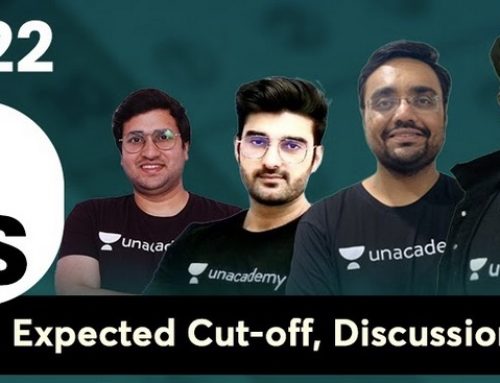
![[Errors/discrepancy] 16 MCQs where UPSC Official Prelims-2020 Answerkey & Coaching classes differ, while 2 MCQs cancelled](https://mrunal.org/wp-content/uploads/2021/11/csp2020-akey-differ-table-500x383.png)
thank you sir so much .. all the articles were very helpful current as well as core .. hope to clear prelims this time … and thank you for analysis and keys … \,,/
Sir,
Thank you so much, please continue to shower your blessings to us in the form of World history and post independence, International affairs, economy– current affairs (GST. etc).
Good work on many counts but regarding Satya sodhak samaj… In page 130 of NCERT, there is no reference to that topic.., kindly be sure about What you say…
I have 90 marks .is it any possibility to clear pre. In st category?
sir with due respect i want to drag your attention towards the question regarding Ajanta and mahabalipuram dateline.In question it is mentioned clearly “two historical places known as Ajanta and Mahabalipuram” so they are asking mahabalipuram as a whole not a particular temple like shore temple which was built around 750 AD.Some monuments were built earlier which coincides with Ajanta construction period.Kindly clarify it..
Medicines sans frontiers was very much in news over last year, for their facilities in Afghanistan were bombed by US while targetting Taliban militants. Then also I think in context of Sudan conflict as well, and more recently for warning the Indian government against its IPR policy which may hurt India’s stature as world’s pharmacy. It was not a tough question. But yes one needs to follow the Hindu continuously over the year.
Bhai wish you could come up with some content in these days when it feels hard to get back on track.
thnk u sir
Sir great job…..ur economic survey series is vry imp not for only ias aspirant for those all who want to knw the economic condition of nation……nd economic lecture series is also relevent in that field …..always keep it up ….u r the true inclusive in the nation of most inequility…..
Thanks ‘Mrunal Bhai’
mrunal sir, we want that besides lecture series you should start a prelims cum mains test series so that even non coaching people people can analyse their prepration, hope you do this
Sir please suggest me which books should buy for IAS mains exam in Hindi language I am new so need guidance
Doctors without border are also in June the hindu
Sir I checked out that above thirty questions directly or indirectly from the hindu
Very good analysis Mrunal sir ….With all ur analysis & other keys getting the score in the range of 106-109..belong to obc..whts my chances? whts ur expected cutoff?
Thank you pratik sir for your wonder full video.. sir please if possible come up IR videos for last one year happening
What is your Message? Search before asking questions & confine discussions to exams related matter only. sir what is expected cutoff?
are u talking about me vivek
Mrunal sir is it possible to talk to you directly sir , if possible plz provide ur contact details to email id, so that I can contact . its really humble request to you sir plz. I need ur advice desperately.
question number 92 will be -(b) only 2 …as siddha in tamil region practice idolatory of Lord Murugan..they were called siddhar ..that is the only exception in tamil nadu where siddha used to practice idolatory(source :wikipedia)
Thank sir for your most valuable support & information
Please launch your app SIR.
helli sir , siddars were practicising idolatoty. ex : bogar siddar who is the follower of murugan is in idol form and many other siddars were also following idolatory .
Thank you sir; one doubt regarding mahabalipuram question…..it is asked in the question that what is common between the two places; as per ncert it is right that shore temple and other rock cut caves were buiid by narasimhavarman in 7 to 8th century a.d; but mahabalipuram was already thriving port city under pallavas from 2nd century a.d; so isnt the first statement is also true
Thank you sir;
one doubt regarding mahabalipuram question…..it is asked in the question that what is common between the two places; as per ncert it is right that shore temple and other rock cut caves were buiid by narasimhavarman in 7 to 8th century a.d; but mahabalipuram was already thriving port city under pallavas from 2nd century a.d; so isnt the first statement is also true
thanks for history series plz plz plz start world history series
sir,
some video lectures in HFS2 series are missing. after HFS2_P4 next video covers recap of previous lectures in HFS3_P1 .
Please upload videos ASAP.
thank you
Tanq sir
Hi sir,
The 92nd question. About the Tamil sittars, I believe the fact is wrong because, among the 18 siddhas, none condemned idolatry. specifically, Bogar one of the most famous constructed the idol of Lord muruga in palani temple … another famous siddha, ‘Agasthya’ worshiped both Lord Shiva and Lord muruga so it cant be monotheistic …. so option should be ‘B ONLY’ — please clarify me
https://en.wikipedia.org/wiki/Palani_Murugan_temple
Dear Mrunal Ji..
Can u share us Medieval India by Meenaxi Jain (2002) Class 11 old NCERT…
All questions of Pre-2016 Medieval India was from that source..
U were posting compiled articles from Meenaxi Jain earlier so I am asking sir…